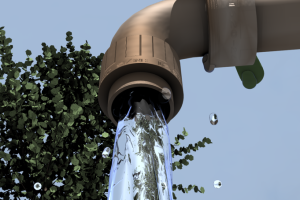A simple paper test strip could save lives by helping millions find clean sources of drinking water | Source: Giacom, July 2, 2013
SUMMARY: A team will first test the invention in Lahore, Pakistan, where it is estimated that more than 60 percent of the water is contaminated. 
There are 2.5 billion people in the world who live without basic sanitation, opening them up to nasty parasites, bacterial infections and viruses that cause millions of deaths a year. Many of these deaths could be prevented with access to clean drinking water; a resource more than 1 billion people live without.
Two teams led by chemist Vincent Rotello of the University of Massachusetts-Amherst want to reduce those deaths and help the billions more who fall ill from contaminated water every year with a simple, affordable strip of paper that can detect bacteria in drinking water. It could reduce the need for expensive equipment, making it easier to gauge water safety in areas of the world that previously could not afford testing.
A U.S. based team will work on scaling techniques to print the strips, while a Pakistan-based team will test them in Lahore — the largest city in Pakistan’s Punjab region. More than 60 percent of the water sources there are estimated to be contaminated.
The strips are composed of a sensor inserted between two pieces of paper that are then coated in nanoparticles. Users dip the strips in water and watch to see if the paper color changes. If bacteria are present, the strips remain white. If the water is safe, they change color. The team had already developed a version that relied on gold nanoparticles, but the strips did not work at the higher temperatures they would be exposed to once in use. The new version will be less temperature sensitive.
The nanoparticles will initially be added to the strips with an inkjet printer that will cost less than $100, ensuring the system is affordable. After the inkjet technique is worked out, the teams want to scale up. The University of Massachusetts-Amherst has a nanomanufacturing facility that they will use to test large-scale printing techniques.
It is very important that the different substances coating the strips do not interact before they are exposed to water, or they risk becoming useless. Rotello said in the release that the team will need to do more work on the strips’ stability and determine their shelf life.
Once the strips are fully developed, the teams could debut them beyond Pakistan. Traditionally, water is tested by bringing a sample back to a lab, where contaminants can be cultured and identified. More recently, testing can be done out in the field with mobile water analysis kits. The Aquatest, which is funded by the Bill and Melinda Gates Foundation, weighs about 4.5 pounds and can test water anywhere. But it still takes 24 hours to incubate the water sample and a second piece of equipment is needed to read the results. The strips are standalone and work nearly instantly.
The strips can’t replace more robust monitoring equipment, as they only test for bacteria. Contaminants such as viruses, parasites and chemicals could still be present in dangerous amounts. But they are such a cheap option that they could do a lot of good. In 2011, a U.N. report called for the development of low-cost paper strip tests, based on promising results from a fecal matter detector strip tested in the Pacific Islands in 2005.
“This is a very nice mix of research and practical outreach in the real world with a goal to improving world health,” Rotello said in a release.


